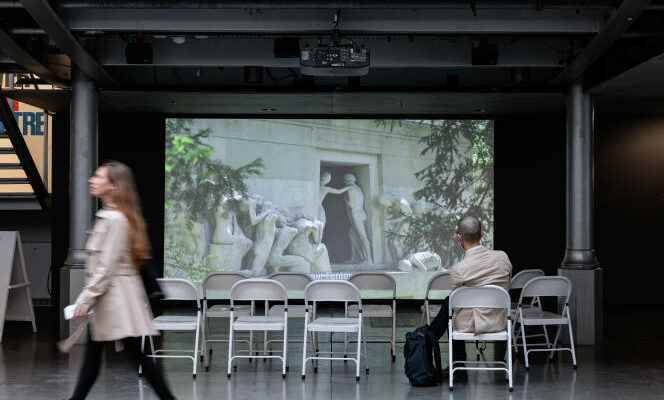ARSENAL PAVILION SITE – ON DEMAND – SHORT FILMS SERIES
“A contemporary writer chooses a district, an area, a place in Greater Paris. The writer then writes a text of the literary genre of his choice, in connection with the space. The camera captures the spirit of the place. At times, correspondences are woven between the text read by the writer in voiceover and the images. At others, deviations develop a new narrative that frees the imagination and interpretations. Between documentary vision and literary fiction, the films will offer snapshots of today’s Greater Paris to draw the portrait of a changing city. »
This is how the series imagined and shot by Stefan Cornic. This art historian by training, passionate about the relationship between art, architecture and cinema, is the author of numerous televised or institutional documentaries.
We were particularly struck by The eye, the brush and the cinematograph (2021), on Arte, in which he took as a postulate, subtly defended, that the cinematographic eye preceded the invention of the cinematograph, by focusing particularly on the setting of the city-spectacle that is Haussmannian Paris.
“A huge empty trapezoid”
For The Greater Paris of writersmade up of three seasons of ten episodes each, Stefan Cornic juxtaposes shots, often fixed and brief, traces axes, lines of flight that certain texts, such as that of Aurélien Bellanger, also evoke: “ When you have your back to the Opera, it’s the portion of space that opens at the top of rue La Fayette, the other axis of Paris, after the royal road – but without Arc de Triomphe, without Defense, with nothing in sight. » The writing takes a cinematic look at “ an immense empty trapezium: the country of France, one of the most beautiful and least known of modern landscapes”.
These are sometimes anecdotes or childhood memories – those of Alice Zeniter in Fontenay-aux-Roses (Hauts-de-Seine) and its two bend streets connected by a small staircase, or of Pierre Assouline, who saw everything by rowing between Puteaux and Courbevoie (Hauts-de-Seine), the district of La Défense comes into being round after round.
The poets are in the game: Jean-Charles Massera (We could not [sa]see), Simon Johannin (City Gagarin) and Jacques Toy (The Mountain P) are expressed in verse; in Melun 2000the novelist, poet and performer Marin Fouqué raps a spicy prose poem that rolls and pitches under the tongue and in the ear, sometimes with musical sounds: “MMMMMMMMMMMMMMMMMM Melun/Moula/Mollard/Molasses/Malaxe/Molossian Malice-ciels Latent word/And the heavens…”
Nuggets
We are touched by the pretty evocation of Père-Lachaise – in the style of Colette, at her window in the Palais-Royal – by Camille Laurens: “In winter, the bare branches show the multitude of gray graves or sometimes covered with snow, it’s very beautiful, even if we think then, fleetingly, of the cold that takes the bodies. As soon as spring arrives, the leaves completely hide the cemetery and suddenly, a change of scenery, I overlook a forest. »
There is also, among the nuggets of this collection, the last Parisian journey of the pedestrian Roland Barthes imagined, in a dispassionate tone, by Laurent Binet, from the rue des Blancs-Manteaux to the Collège de France where he went, just before the accident where the essayist and semiologist was mowed down by a laundry van, on February 25, 1980, before dying, hospitalized, a month later.
Night classes
How to look at a painting? Discover our art history course with Françoise Barbe-Gall
The World Workshops
If she most often looks at the urban and peri-urban elements evoked by the texts during these three available seasons, Stefan Cornic’s camera is not strictly illustrative. She doesn’t take the opposite view either, which would be artful, but weaves a sort of counterpoint.
There is no aesthetic desire, and we see Paris as we have known it since the period of Covid-19 and confinement in particular: not always clean, often bottled and adorned with these terraces which have swarmed and persist. But this polyphonic love letter to Paris intra and extra-muros remains a touching mosaic of fragments of urban discourse.
The Greater Paris of writers, documentary series by Stefan Cornic with contributions from Pierre Assouline, Aurélien Bellanger, Laurent Binet, Patrice Blouin, Olivier Cadiot, Thomas Clerc, Laurence Cossé, Marie Darrieussecq, Julia Deck, Marin Fouqué, Faïza Guène, Célia Houdart, Maylis de Kerangal, Philippe Jaenada, Simon Johannin, Jacques Toy, Camille Laurens, Nina Leger, Jean-Charles Massera, Valérie Mréjen, Emmanuelle Pireyre, Eric Reinhardt, Marie Richeux, Régine Robin, Ryoko Sekiguchi, Leïla Slimani, Joy Sorman, Fanny Taillandier, Delphine de Vigan , Alice Zeniter (Fr., 2019-2022, 4 min-6 min). On the Arsenal Pavilion website.
